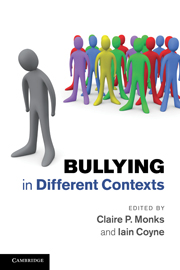Book contents
- Frontmatter
- Contents
- List of figures
- List of tables
- Notes on contributors
- 1 A history of research into bullying
- 2 Peer-victimisation in preschool
- 3 Bullying in schools: thirty years of research
- 4 Peer violence in residential children's homes: a unique experience
- 5 Domestic violence: bullying in the home
- 6 Juvenile dating and violence
- 7 Bullying in prisons: bringing research up to date
- 8 Bullying in the workplace
- 9 Elder abuse and bullying: exploring theoretical and empirical connections
- 10 Cyberbullying
- 11 An overview of bullying and abuse across settings
- Index
- References
7 - Bullying in prisons: bringing research up to date
Published online by Cambridge University Press: 05 June 2012
- Frontmatter
- Contents
- List of figures
- List of tables
- Notes on contributors
- 1 A history of research into bullying
- 2 Peer-victimisation in preschool
- 3 Bullying in schools: thirty years of research
- 4 Peer violence in residential children's homes: a unique experience
- 5 Domestic violence: bullying in the home
- 6 Juvenile dating and violence
- 7 Bullying in prisons: bringing research up to date
- 8 Bullying in the workplace
- 9 Elder abuse and bullying: exploring theoretical and empirical connections
- 10 Cyberbullying
- 11 An overview of bullying and abuse across settings
- Index
- References
Summary
As a topic of academic study, bullying between prisoners has not seen the same volume of research as that dedicated to other populations, such as bullying among children or within the workplace. Indeed, the first studies into prison bullying were published only in 1996 (Connell and Farrington, 1996; Ireland and Archer, 1996), and even now there is a tendency for research into prison aggression to be published which makes no reference to the concept of bullying (Blitz et al., 2008) nor to any UK prison-based research. This is despite the fact that the UK has led this area, coupled with a marked increase in prison bullying research across the last decade (e.g. Ireland and Ireland, 2008), which has included in excess of 50 publications. Bullying among prisoners is a topic of particular interest on a number of grounds: academically, you have the opportunity to explore aggression between sex-segregated groups representing extreme samples of the general population, samples who are residing in unique environments that arguably serve to promote bullying behaviour (Ireland, 2005); and on practice-grounds, there is a need to refine and evaluate prison-based anti-bullying strategies and approaches, accounting for the elevated levels of bullying reported in comparison to other populations, and the absence of theory evident in current strategies (Ireland, 2005).
- Type
- Chapter
- Information
- Bullying in Different Contexts , pp. 137 - 156Publisher: Cambridge University PressPrint publication year: 2011
References
- 3
- Cited by



